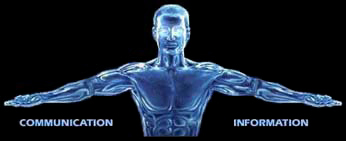Introduction
We encourage you to verify the source images for yourself, rather than just simply accept the facts that are presented here.
Exact details of the used image templates can be found here.
Some reports on this website are based on previous ones. So it is extremely important to read the reports in chronological order.
Details can turn up that were probably already been analyzed in detail. If you are new here and you directly start reading the
recent reports without prior knowledge, then it could happen, that the required context is not recognizable.
You do yourself and us a favor when you first start with the oldest reports.
This is the first analysis report regarding the Terby crater. There are no previous reports. You can continue to read here.
Target Area
Image Source: Mars Global Surveyor
Labeling: MOC Image r0401387
Coordinates: -27.164 North / 74.455 East
Target Area: Nothern part of the Terby Crater
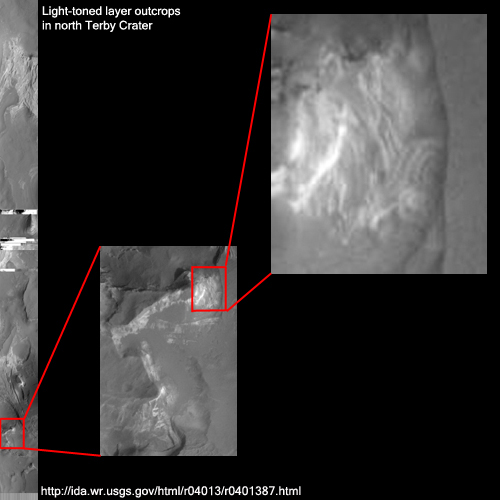
Enlarged detail of the relevant target area
The original image can be quickly found using a search engine, specifying the image name above.
It is also possible to enter the web address in your browser that is included in the above image
or click
here  , to directly visit the website. , to directly visit the website.
In the overall view of the original photo strip no anomalies are visible. Even larger objects should
be difficult to spot, since the considered area has dimensions of 3 km in width and 43.36 km in length.
Without magnification many important details remain undetected.
This photo shows the northern part of the Terby crater. Particularly interesting is the lower part of the
image. Here is a bright strip that runs along several rock ledges.
At the one end of the bright rock strip a formation of circular lines running into each other is visible and
some lines run upwardly away. A closer examination seemed worthwhile, since stylized figures were already recognizable.
First image reconstruction of the Terby geoglyph
For better orientation a contrast-enhanced view in the middle image segment.
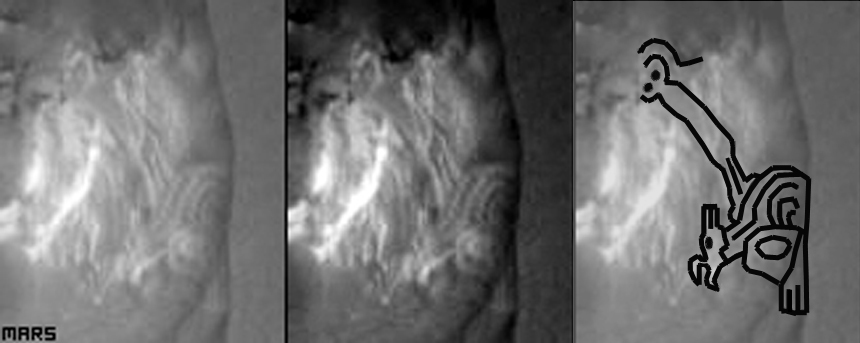
Click on image to enlarge
The tracing and highlighting of the lines allows a better visualization and accurate determination of the alignment.
It makes sense to try this approach for yourself. A simple image-editing program is all you need.
Our interpretation of the line structure shows that we are dealing here with two characters. Such figures drawn on a
large area on the ground or on rocks are generally called geoglyphs. We therefore use the term "geoglyph". The lower geoglyph shows a
not clearly identifiable figure/animal. This animal geoglyph seems to have a beak, protruding ears (or horns) and paws.
Moreover, it seems to be in a kind of squatting position.
It looks like that on the back of the animal figure stands another figure whose lines can not be fully represented.
Here too, only the clearly recognizable lines are highlighted. The head of the figure can not be fully pictured. One interpretation
would be that of a laterally looking figure that seems to be wearing a kind of helmet. But another interpretation of this form
shows a forward-looking figure with two circular eyes, which again seems to wear a helmet and holds his arm over his head. We finally decided on this
and and highlighted it this way. Somehow it seemed to be the right presentation and for some reason this character
looked familiar.
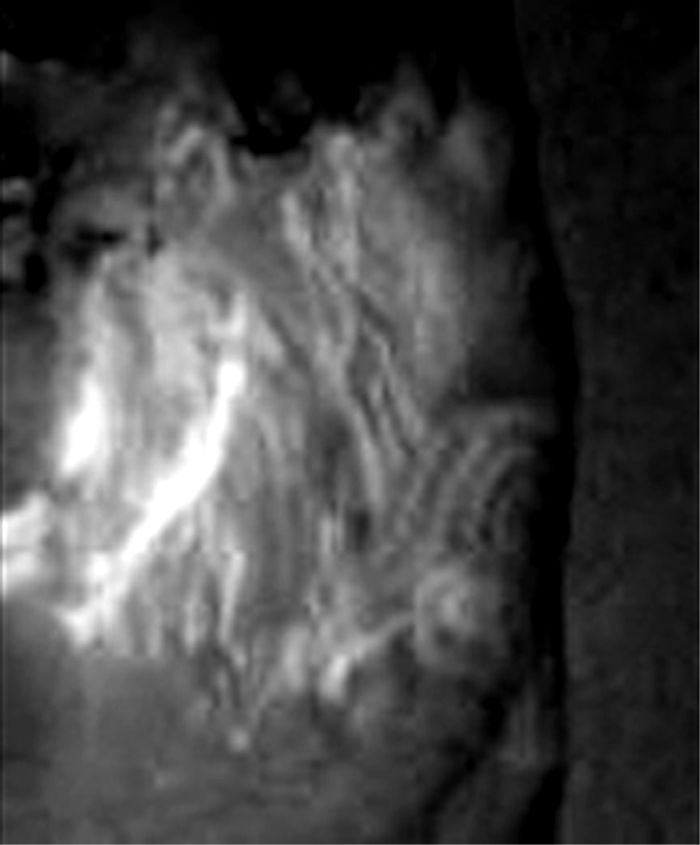
Click on image to enlarge
The alignment shows several parallel lines. A very striking representation. A well known example of the geoglyphs
is the Nazca plain in Peru. The illustrations in Nazca show a spider, a monkey, a lizard, and many other species exhibit the same
line characteristics, such as the animal Mars geoglyph.
But what's up with the character who seems to stand on the animal? With the help of Google's image search, it is possible
to find numerous geoglyphs photos from Nazca, by using the keyword "Nazca". If you browse in the search results a few pages
further, you will see that the Nazca plain holds a figure with striking resemblance to the Mars geoglyph.
Image reconstruction of the Nazca geoglyph
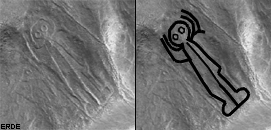
Among experts this geoglyph from the peruvian Nazca plain is, ironically, also known as "the astronaut" or "El Astronauto".
For a comparison of the two figures, an appropriate template from the Google results is selected and displayed in gray display,
in order to adapt the image with that form Mars. Here too, only the clearly recognizable lines are highlighted.
Comparison of Terby and Nazca geoglyphs
Further alignments

Left: Geoglyphs from the Terby crater / Right: Geoglyph form the Nazca plain
Increasing the contrast values is a basic technique for image reconstruction in such image templates.
A better interpretation can be achieved by increasing magnification.
Completion of the lines (artistic interpretation in red)
The following figure shows in red the rest of the missing lines in both images in order to make them identical in their shape now.
This is, of course, an artistic intepretation. So we are using red lines to illustrate this kind of intepretation. Whether this is
a fantasy or a realistic assessment, the decision is left to the viewer.
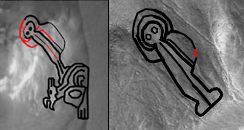
Left: Geoglyph from the Terby crater / Right: Geoglyph from Nazca plain
There are still more lines that were not highlighted here.
The Terby geoglyph shows in the left pane natural rock dislocations. These dislocations are outside a meaningful interpretation.
Interestingly, however, are further alignments which can be found along the Nazca geoglyph. You can see it in the shown picture,
significantly in the areas of the legs. These were not highlighted because they are not belonging directly to the alignment of the character.
The reason for this will be explained in the next section.
Detail explained - Prominent alignments
The Nazca astronaut geoglyph from a different viewing angle.
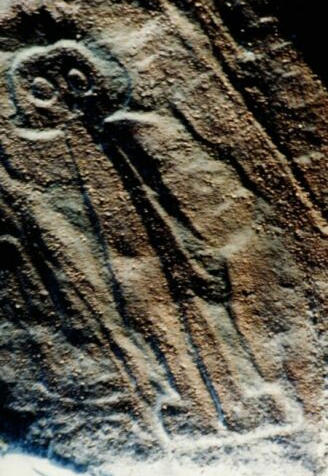
From this perspective the figure shows some striking features. The supposed second line arises from a depression which runs around
the figure and increases the depth effect. Depending on the viewing angle it also brings out different lines, while other lines disappear.
The picture also clarifies another detail. A large amount of photos
of the so called astronaut geoglyph were made from a greater distance (often made out of chartered Cessnas that regularly fly over this area)
and with the same viewing angle too. Thus many people can not explain why the figure shows several dents.
Here one sees the reason for the deformations on the right side of the figure. It arises because the figure's right arm
hangs down and protrudes his fingers to the side. This detail is also present in the Terby geoglyph at exactly the same place!
This example shows that many details can be explained by using shots from different viewing angles. This kind of geoglyph works primarily with
elevations and depressions and it appears not clumsy in its execution, as some would perhaps expect. In fact, quite the contrary is the case. It
appears only from afar to consist of simple lines. But depending on the viewing angle and distance, it reveals many new details. Above all,
one should note that this geoglyph decays slowly by the time and the weather. The good state of preservation may also be due to the fact how this
glyph was made. Instead of just using simple color painting, this geoglyph was created with the help of depression that is much more resistant
to weathering.
Style comparison between the Mars geoglyph and the Nazca geoglyphs on earth
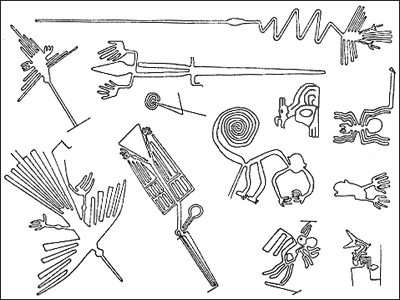
The animal nature fits discreetly into the collection of registered Nazca geoglyphs. At the current state of research, a similar picture
of the Terby animal can not be found in the Nazca plain.
Of course one can not ignore that the Nazca geoglyph called "El Astronauto" has no animal figure under its feet.
However, one must also note here that the area below the figure is strongly eroded. Whether another
Geoglyph was there, is probably not verifiable.
What would we think, if we would see here on earth a rock "painting", which shows a man standing on an animal like the Terby geoglyphs on Mars?
Of course, such a presentation would be more likely to be interpreted in a symbolical way, because due to its proportions it does not show a
realistic picture regarding the weight of the person and the potential viability of the animal. But such symbolism, at least subliminally conveys
certain values at which "man" rules over the animal.
Doubt, whether the figure is the result of natural conditions are certainly justified.
The parallels with terrestrial geoglyphs and the depicted symbolism are quite astounding, assuming that this is done by nature.
But how is the probability that all details shown here are purely natural origin?
To underscore the artificiality of this structure it is necessary to find further examples.
An examination of the Terby crater appears to make sense, unless there are further high-resolution images from this area.
|
